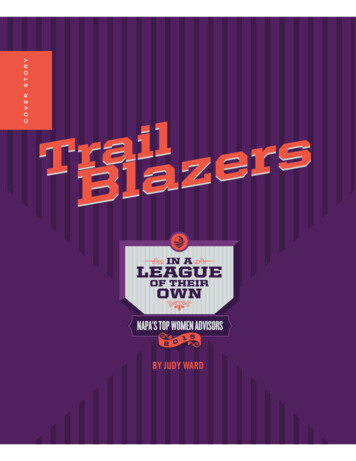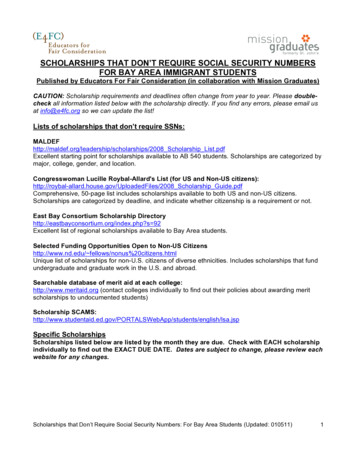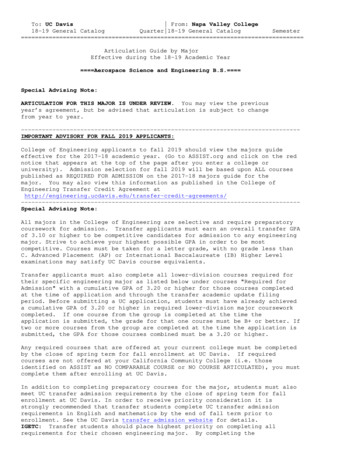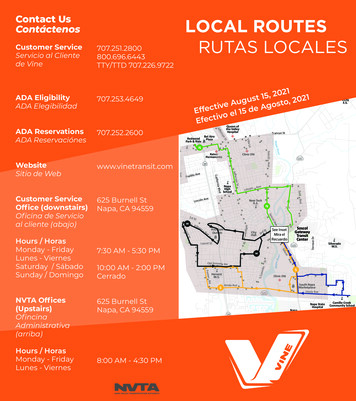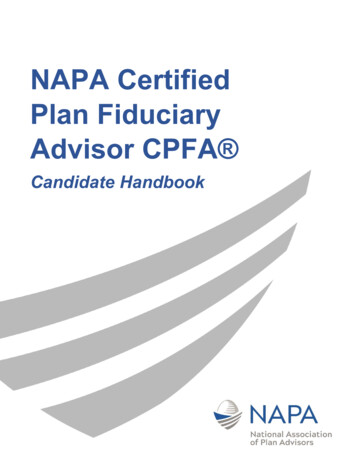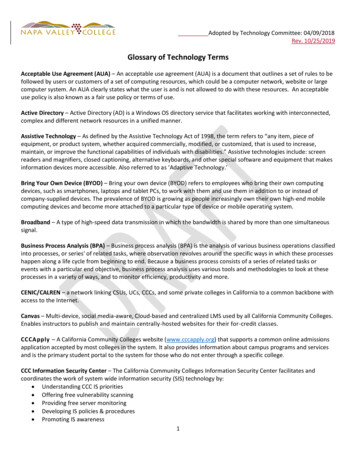
Transcription
Adopted by Technology Committee: 04/09/2018Rev. 10/25/2019Glossary of Technology TermsAcceptable Use Agreement (AUA) – An acceptable use agreement (AUA) is a document that outlines a set of rules to befollowed by users or customers of a set of computing resources, which could be a computer network, website or largecomputer system. An AUA clearly states what the user is and is not allowed to do with these resources. An acceptableuse policy is also known as a fair use policy or terms of use.Active Directory – Active Directory (AD) is a Windows OS directory service that facilitates working with interconnected,complex and different network resources in a unified manner.Assistive Technology – As defined by the Assistive Technology Act of 1998, the term refers to “any item, piece ofequipment, or product system, whether acquired commercially, modified, or customized, that is used to increase,maintain, or improve the functional capabilities of individuals with disabilities.” Assistive technologies include: screenreaders and magnifiers, closed captioning, alternative keyboards, and other special software and equipment that makesinformation devices more accessible. Also referred to as ‘Adaptive Technology.’Bring Your Own Device (BYOD) – Bring your own device (BYOD) refers to employees who bring their own computingdevices, such as smartphones, laptops and tablet PCs, to work with them and use them in addition to or instead ofcompany-supplied devices. The prevalence of BYOD is growing as people increasingly own their own high-end mobilecomputing devices and become more attached to a particular type of device or mobile operating system.Broadband – A type of high-speed data transmission in which the bandwidth is shared by more than one simultaneoussignal.Business Process Analysis (BPA) – Business process analysis (BPA) is the analysis of various business operations classifiedinto processes, or series' of related tasks, where observation revolves around the specific ways in which these processeshappen along a life cycle from beginning to end. Because a business process consists of a series of related tasks orevents with a particular end objective, business process analysis uses various tools and methodologies to look at theseprocesses in a variety of ways, and to monitor efficiency, productivity and more.CENIC/CALREN – a network linking CSUs, UCs, CCCs, and some private colleges in California to a common backbone withaccess to the Internet.Canvas – Multi-device, social media-aware, Cloud-based and centralized LMS used by all California Community Colleges.Enables instructors to publish and maintain centrally-hosted websites for their for-credit classes.CCCApply – A California Community Colleges website (www.cccapply.org) that supports a common online admissionsapplication accepted by most colleges in the system. It also provides information about campus programs and servicesand is the primary student portal to the system for those who do not enter through a specific college.CCC Information Security Center – The California Community Colleges Information Security Center facilitates andcoordinates the work of system wide information security (SIS) technology by: Understanding CCC IS priorities Offering free vulnerability scanning Providing free server monitoring Developing IS policies & procedures Promoting IS awareness1
Adopted by Technology Committee: 04/09/2018Rev. 10/25/2019 Publicizing important IS informationCloud (the) – The cloud is a friendly way of describing web-based computing services that are hosted outside of ourorganization. When you use cloud-based services, the IT infrastructure resides off our property (off-premises) and ismaintained by a third party (hosted) instead of residing on a server on campus (on-premises) maintained by NVCtechnology staff.CISCO – One of the leading manufacturers of network equipment. Cisco's primary business is in internetworkingproducts.Colleague – The College’s primary SIS/ERP software created by Datatel.Colleague Self Service – An interactive robust web application that enables users to interact with their individualinformation in the Colleague databases. Self-Service modules include Financial Aid, Student Planning, Finance, and HR.Computer Aided Design (CAD) – The use of computer programs and systems to design detailed two- or threedimensional models of the physical.Coupling – A linkage between each part of a system such that if one part is modified, the behavior of other parts mayalso be affected. The degree to which each system module relies on each of the other modulesDatatel – The company behind the development of the Colleague ERP, a college-wide computer software system usedto manage and coordinate all of the resources, information, and functions of the college from shared data sources.Data Transfer – The ability to import and export information (as appropriate) that is stored in databases to known,commonly used formats, e.g., Delimited files (comma, tab, fixed length), IMS, XML.Disaster Preparedness/ Recovery Plan – A Disaster Recovery Plan (DRP) is a business plan that describes how work canbe resumed quickly and effectively after a disaster. Disaster recovery planning is just part of business continuityplanning and applied to aspects of an organization that rely on an IT infrastructure to function. The overall idea is todevelop a plan that will allow the IT department to recover enough data and system functionality to allow a business ororganization to operate - even possibly at a minimal level.Distance Education – Transmission of instruction to students at a location separate from the institution.DNS (Domain Name System) – The domain name system (DNS) stores and associates many types of information withdomain names, but most importantly, it translates domain names (computer hostnames) to IP addresses.Domain – A group of computers on a network that share a common directory or storage location.Domain name – The most common type of domain names are hostnames that provide more memorable names to standin for numeric IP addresses.Ellucian – A company which provides software and services to the higher education industry and is the owner of theBanner and Colleague ERP systems. In 2011, Datatel and SunGard Higher Education merged to form the new companyand is currently owned by private equity firms TPG Capital and Leonard Green Partners.2
Adopted by Technology Committee: 04/09/2018Rev. 10/25/2019Enterprise Architecture (EA) – The practice of applying a comprehensive and rigorous method for describing a currentand/or future structure and behavior for an organization's processes, information systems, personnel and organizationalsub-units, so that they align with the organization's core goals and strategic direction.Enterprise Architecture Principles – A set of guiding and value based criterion to be applied to increase consistency andquality in technology decision making.Enterprise Resource Planning (ERP) – Enterprise resource planning (ERP) is a method of efficiently utilizing people,hardware and software to increase productivity and profit, thus simplifying a company’s business processes. ERP mayinclude many software applications or a single (but more complex) software package that smoothly disseminates datarequired by two or more unique business departments.Feasibility Study – designed to provide an overview of the primary issues related to a technology project. The purpose isto identify any “make or break” issues that would prevent the project from being successful in meeting requirementsand goals of the project. In other words, a feasibility study determines whether the technical approach makes sense. Afeasibility study will include an evaluation of alternative approaches and rationale why the selected systems werechosen.FTP or File Transfer Protocol – used to connect two computers over the Internet so that the user of one computer cantransfer files and perform file commands on the other computer.Hyper V – Microsoft Hyper-V is a server virtualization product developed by Microsoft Corporation, which providesvirtualization services through hypervisor-based simulations.Information Technology Infrastructure Library (ITIL) – Information technology infrastructure library (ITIL) is a widelyaccepted best practices framework for IT service management (ITSM). ITIL includes practices, checklists, tasks andprocedures documenting the role of the ITSM function. Additionally, ITIL is supported by a qualification scheme,accredited training organizations and implementation third-party (also called ITIL-aligned) assessment tools.Infrastructure – the physical components and associated software used to support the flow and processing ofinformation.Learning Management System (LMS) – Software for delivering, tracking and managing education or training. LMSsrange from systems for managing training/educational records to software for distributing courses over the Internet andoffering features for online collaboration.Local Area Network (LAN) – A local area network (LAN) is a computer network within a small geographical area such as ahome, school, computer laboratory, office building or group of buildings. A LAN is composed of inter-connectedworkstations and personal computers which are each capable of accessing and sharing data and devices, such asprinters, scanners and data storage devices, anywhere on the LAN.Microsoft Exchange – Microsoft Exchange Server (Exchange) is a collaborative enterprise server application designed byMicrosoft to run on Windows Servers. Exchange supports: Email Contacts and tasks Calendar3
Adopted by Technology Committee: 04/09/2018Rev. 10/25/2019Management Information System (MIS) – Refers to computer-based systems that manage student, fiscal and otherinformation. The CCC MIS database is comprised of unit record student and staff data from all colleges in the system.Project – A human endeavor, involving a team of personnel, plans, actions, and outcomes, which are directed atdeveloping and / or maintaining an information technology based system to achieve a set of goals, within a specifiedtimeline, and within budget.Project Management Institute – The Project Management Institute (PMI) is a leader in credentialing projectmanagement professionals and advancing the field of project management.Project Management Professional (PMP) – Project Management Professional (PMP) credential is the most importantindustry-recognized certification for project managers. Globally recognized and demanded, the PMP demonstratesexperience, education and competency to lead and direct projects.Technology Refresh Plan – A systematic plan to replace systems, such as computers, before they break or becomeobsolete.ROI (Return on Investment) – the ratio between the net profit and the costs of a purchase or investment.SARS (Student Appointment and Reporting System) – Web-based student appointment system widely used by StudentAffairs offices. Program features an automated messaging system, as well as a student self-serve check-in/check-outsystem for services throughout campus.Service Level Agreement (SLA) – A Service Level Agreement (SLA) is the service contract component between a serviceprovider and customer. A SLA provides specific and measurable aspects related to service offerings.Single Sign-on (SSO) – Single sign-on (SSO) is an authentication process that allows a user to access multiple applicationswith one set of login credentials. SSO is a common procedure in enterprises, where a client accesses multiple resourcesconnected to a local area network (LAN). SSO advantages include: Eliminates credential re-authentication; thus, improving productivity Streamlines local and remote application and desktop workflow Minimizes phishing Improves compliance through a centralized database Provides detailed user access reportingSystem Administrator – The person primarily responsible for maintaining a multi-user computer system.System-wide Information Security (SIS) – A comprehensive approach to ensuring LAN/WAN security.Thin Client – A way to configure a group of computers (e.g. a lab) in which the data processing occurs at a centralizedserver.TCO (Total Cost of Ownership) – Includes initial purchase price, costs of maintenance and support, repairs, warranties aswell as any unintended costs over the life of the product.Voice over Internet Protocol (VOIP) – The protocol which allows telephone calls to be made over computer networks.4
Adopted by Technology Committee: 04/09/2018Rev. 10/25/2019WebAdvisor – The student and faculty interface to Colleague.Virtualization – Virtualization refers to the creation of a virtual resource such as a server, desktop, operating system,file, storage or network. The main goal of virtualization is to manage workloads by radically transforming traditionalcomputing to make it more scalable. Virtualization has been a part of the IT landscape for decades now, and today it canbe applied to a wide range of system layers, including operating system-level virtualization, hardware-level virtualizationand server virtualization.Virtualized Desktop Infrastructure (VDI) – Virtual desktop infrastructure (VDI) is a virtualization technique enablingaccess to a virtualized desktop, which is hosted on a remote service over the Internet. It refers to the software,hardware and other resources required for the virtualization of a standard desktop system.VMWare – VMware is a company that was established in 1998 and provides different software and applications forvirtualization. It has become one of the key providers of virtualization software in the industry.VPN (Virtual Private Network) – a technology that creates a safe and encrypted connection over a less secure network,such as the internet. VPN technology was developed as a way to allow remote users and branch offices to securelyaccess corporate applications and other resources.WCAG (Web Content Accessibility Guidelines) – Covers a wide range of recommendations for making Web contentmore accessible to a wider range of people with disabilities.Wi-Fi – wireless networking technology that uses radio waves to provide wireless high-speed Internet and networkconnections. Allows computers and other devices to communicate over a wireless signal.Some definitions contained within this document were provided by the following sources:o www.techopedia.como http://en.wikipedia.orglwikilDomain name system5
Disaster Preparedness/ Recovery Plan - A Disaster Recovery Plan (DRP) is a business plan that describes how work can be resumed quickly and effectively after a disaster. Disaster recovery planning is just part of business continuity planning and applied to aspects of an organization that rely on an IT infrastructure to function.

